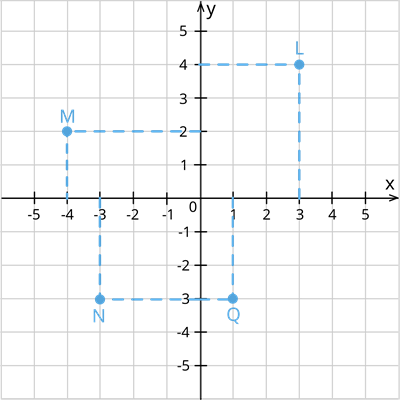
PUMPA - SMART LEARNING
எங்கள் ஆசிரியர்களுடன் 1-ஆன்-1 ஆலோசனை நேரத்தைப் பெறுங்கள். டாப்பர் ஆவதற்கு நாங்கள் பயிற்சி அளிப்போம்
Book Free Demo\(x\)-co-ordinate of a point:
The \(x\)-coordinate of a point is the perpendicular distance from the \(y\)-axis measured along the \(x\)-axis.
\(y\)-co-ordinate of a point:
The \(y\)-coordinate of a point is the perpendicular distance from the \(x\)-axis measured along the \(y\)-axis.

1. The perpendicular distance of the point \(L\) from the \(y\)-axis measured along the positive direction of the \(y\)-axis is \(LX=4\) units and the perpendicular distance of the point \(L\) from the \(x\)-axis measured along the positive direction of the \(x\)-axis \(OL=3\) units.
Point \(L\) lies at the first quadrant in the above graph; hence its co-ordinates will be represented as \((x, y)\), where \(x=3\) and \(y=4\) is the co-ordinate of \(L\) in cartesian plane is represented as \((3,4)\).
2. The perpendicular distance of the point \(M\) from the \(y\)-axis measured along the positive direction of the \(y\)-axis is \(MX'=2\) units and the perpendicular distance of the point \(M\) from the \(x\)-axis measured along the negative direction of the \(x\)-axis \(OM=2\) units.
Point \(M\) lies at the second quadrant in the above graph; hence its co-ordinates will be represented as \((-x, y)\), where \(x=4\) and \(y=2\) is the co-ordinate of \(M\) in cartesian plane is represented \((-4,2)\).
3. The perpendicular distance of the point \(N\) from the \(y\)-axis measured along the negative direction of the \(y\)-axis is \(NX'=3\) units and the perpendicular distance of the point \(N\) from the \(x\)-axis measured along the negative direction of the \(x\)-axis \(OX'=2\) units.
Point \(N\) lies at the third quadrant in the above graph; hence its co-ordinates will be represented as \((-x, -y)\), where \(x=2\) and \(y=3\) is the co-ordinate of \(L\) in cartesian plane is represented as \((-2,-3)\).
4. The perpendicular distance of the point \(Q\) from the \(y\)-axis measured along the negative direction of the \(y\)-axis is \(QX=3\) units and the perpendicular distance of the point \(Q\) from the \(x\)-axis measured along the positive direction of the \(x\)-axis \(OX = 1\) unit.
Point \(Q\) lies at the fourth quadrant in the above graph; hence its co-ordinates will be represented as (x, -y), where \(x=1\) and \(y=3\) is the co-ordinate of \(L\) in cartesian plane is represented as \((1,-3)\).
Important!
Measure the positive coordinate value along the positive direction of the axis and the negative coordinate value along the negative direction of the axis.